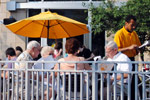
Author Archives: ryochum
-
Operation Safety Net to House Homeless on S. Side
Tuesday, July 13, 2010By Meredith Skrzypczak, Pittsburgh Post-GazetteMoving from riverbanks and alleyways into apartments with bedrooms and bathrooms will become a reality for 16 homeless individuals currently living on the streets of Allegheny County.
The move will be made possible by a federal grant awarded to a local agency last week for construction of housing on the South Side.
Operation Safety Net, which provides services such as medical treatment for the homeless, received $1.69 million for the construction of Trail Lane Apartments on Ninth Street on the South Side.
Operation Safety Net is sponsored by Pittsburgh Mercy Health System. The money is part of $14 million in funding across Pennsylvania announced last week by Housing and Urban Development Secretary Shaun Donovan. A total of $3.3 million was given to agencies in Allegheny County to address homelessness in the area.
The apartment program will help the chronic homeless population, said Linda Sheets, program director for Operation Safety Net. These are individuals who have been living on the streets for at least one year and have some mental illness, she said.
They are often the most difficult to reach and house, but Ms. Sheets said she is expecting full occupancy in the apartments by summer of 2011. Case managers and social workers for the agency already have high-risk individuals in mind who would be good candidates for the housing.
Ms. Sheets said she is most excited about “giving each one of these individuals a chance to have a place of their own.”
Housing will be offered to the 16 individuals for as long as they choose to stay. Staff will help them look for employment and apply for disability income. Once they get a job or are approved for disability, they will be asked to pay 30 percent of their income to cover program fees, which results in a type of rent payment.
A sort of “haven” for the homeless, the apartments will be located on the third floor of a new building, with administrative and training offices on the second floor and a primary care physician and dentist office on the first.
The services provided will not be mandatory, nor are the homeless required to stay, but Ms. Sheets said she hopes the residents will take advantage of the services such as mental health care.
“When a street homeless person leaves the streets and enters into a housing unit we’re very pleased,” she said. “However, when they also want to receive the additional treatment, that keeps them from returning to the streets.”
Over a two-year period, the total cost for the apartments and associated staffing costs will be just over $2 million. Construction could begin as soon as this summer, said Mike Lindsay, housing program administrator for the Allegheny County Department of Human Services. Mercy applied for the grant in mid-2009, he said.
Ninth Street already is home to Mercy Behavioral Health facilities with a pharmacy, shopping and grocery stores nearby. The location is ideal for the 16 future apartment residents looking to become more integrated into the community, Ms. Sheets said.
Some residents in the neighborhood said the inclusion of the apartments for the homeless would be an “over-saturation,” given the existing facilities in the area.
Nancy Wells, 62, a South Side resident, said she agrees with the cause but would not support a homeless population moving onto her street.
“I feel this area is already contributing to helping people in the community,” she said.
A nearby bridge has anywhere from five to 20 people living underneath on a given day, said Ziad Khalil, owner of Zeeno’s, located just minutes from where the apartments would be built. Mr. Khalil would support any program that might lower that number even if it means homeless individuals moving into his area. He said it could bring “positive change.”
Earlier in the year, Jane Miller, director of community and government relations for Mercy Behavioral Health, conducted community meetings to gauge residents’ reactions.
“Nobody came,” she said.
Since then, there has been no opposition, Ms. Miller said, and soon-to-be neighbors of the homeless shouldn’t be worried.
“We share the world with people with mental illness,” she said. “People who are coming here are being treated.”
Dr. Jim Withers, medical director and founder of Operation Safety Net, said this is just the start of support for the homeless.
“You can get people from the streets into housing, but that’s just the beginning of the story.”
-
Fundraiser Puts Lawrenceville Empty Pool to Use
By Craig Smith
PITTSBURGH TRIBUNE-REVIEW
Sunday, July 11, 2010Retired Pittsburgh police officer Marty Joyce heard loud music in his Lawrenceville neighborhood Saturday afternoon and went to investigate.
The Leslie Park Pool, now empty of water, was filled with Zumba dancers who were helping to heighten awareness of a campaign to find alternative uses for the pool and to raise funds for gulf oil spill restoration efforts.
“There used to be lots of kids here. It was always jumping,” Joyce said of the pool where he used to take his son.
Modeled after an effort at the McCarren Park Pool in Greenpoint, Brooklyn, that was closed two decades ago and reopened as a concert venue, the Lawrenceville event was part of the inaugural series being staged by the Leslie Park Pool Collective, a community group working to reuse the decommissioned pool as a multi-use event and performance space.
Proceeds from the event, called the “Spillapalooza,” benefit the Gulf Restoration Network. Organizers said they hadn’t set a dollar goal but expected to be able to send some donations to the Gulf Coast group.
The Leslie Park Pool was closed in 2003, when Pittsburgh decommissioned 16 city pools. Some are being reused, but the Leslie Park Pool has sat vacant. Estimates for needed repairs were more than $1 million.
Neighborhood residents working as the Leslie Park Pool Initiative launched an effort to “reimagine” and redevelop the pool. Last year, they held an Accordion Pool Party that attracted about 600 people and included a clean-up that pulled almost half a ton of garbage from the property.
The Spillapalooza enabled Beth Renshaw to take her second Zumba class of the day. Zumba is a fitness program inspired by Latin dance. “It’s a fabulous cause, and I love Zumba. Why wouldn’t I be here?” said Renshaw of Shadyside, who left the event to play volleyball.
There will be more fundraising for the Gulf Coast and more events to help rethink use of the empty pool, organizers said.
“This is not a one and done thing,” said Shane Freeman, who organized the grassroots group that staged yesterday’s event. It came together in a month and a half, he said.
Next up at the pool is a surf music concert on July 24.
-
Airport Museum to Welcome Visitors Every Weekend
By A.J. Panian, TRIBUNE-REVIEW
Wednesday, June 9, 2010Since attracting about 300 visitors in just one weekend recently, the KLBE Air Museum will be open every weekend this summer.
More volunteers are being sought for the facility dedicated to aviation history at Arnold Palmer Regional Airport in Unity, said board member Don Rossi at a meeting Tuesday of the Westmoreland County Airport Authority.
“We’re looking for anyone with artistic ability and a love of aviation history … anybody capable of working with displays,” said Rossi, a pilot who owns the hangar housing the museum.
The museum opened for the first time to a throng of onlookers from 10 a.m. to 2 p.m. on May 29 and May 30. It will continue to operate during those hours Saturdays and Sundays, starting this weekend. There is no charge for admission, but parking is limited.
Volunteers are needed to sift through a large number of photographs and memorabilia and coordinate the items into presentable exhibits.
“The more volunteers we get that are capable of doing the work, the more exhibits we can complete,” Rossi said.
In official flight-tracking terms, “K” means airport, and “LBE” means Latrobe.
The museum features “Old Blue” — a vintage, single-engine Stinson Reliant — along with a life-sized MiG15 UTI, a 1967 Cessna 150, and a Great Lakes Co. aircraft. It has a 24-seat theater outfitted with airline seats, where audiences can watch aviation-related films.
The facility is on the airport’s east ramp, along Route 981, across from Kennametal.
Those interested in volunteering are asked to call the airport authority office at 724-539-8100.
-
Fallingwater Cottage Designs on Display at Carnegie
By Kurt Shaw, PITTSBURGH TRIBUNE-REVIEW
Wednesday, June 30, 2010
The jury chose the entry of Patkau Architects as the winner of this first-ever design competition. Their design shows that the juxtaposition of the project to Fallingwater is not as important as the juxtaposition of the project to the landscape, being that it proposes building the cabins into the rolling hillside. Patkau Architects
Located in Mill Run, just 90 minutes by car southeast of Pittsburgh, Frank Lloyd Wright’s Fallingwater is an icon of 20th-century architecture that draws approximately 150,000 admirers from around the world, all year long.
Built between 1936 and 1939 for the Kaufmann family — owners of the Pittsburgh department store — it was intended to be a second home, a vacation retreat deep in the woods, hovering above a small waterfall in Bear Run.
Today it stands alone, as it did in 1963, when Edgar Kaufmann Jr. transferred ownership of the house and landscape to the Western Pennsylvania Conservancy. But imagine, if you will, what it would be like if the surrounding Bear Run Nature Reserve, which has grown to 5,061 acres, were filled with cabins, like the countless other cabin-filled enclaves located throughout Western Pennsylvania?
As Fallingwater reaches its 75th anniversary, the conservancy decided to answer that question by inviting six architectural practices — three from the United States and three from Canada — to design cottages for a site a short distance from the main house.
All six proposals are currently on display at Heinz Architectural Center at the Carnegie Museum of Art in the exhibit “Design Competition: New Cottages at Fallingwater.”
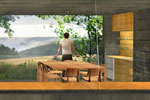
The second-place winner was Wendell Burnette Architects. Their proposal would be above ground, but integrated nonetheless among the forest. Wendell Burnette Architects
The participating firms, each known for environmental sensitivity, are Marlon Blackwell Architect, Fayetteville, Ark.; Wendell Burnette Architects, Phoenix, Ariz.; MacKay-Lyons Sweetapple Architects, Halifax, Nova Scotia; Olson Kundig Architects, Seattle, Wash.; Patkau Architects, Vancouver, British Columbia; and Saucier + Perrotte Architectes, Montreal, Quebec
Each practice was allowed four 24-inch-by-36-inch boards and one model representing a typical cottage unit. The firms were encouraged to give their own unique spin on it, with the additional goal of creating a sustainable design.
Intended to house students and/or teachers during onsite residency programs, the structures were planned to be LEED-certified platinum, which is energy efficient, site sensitive and low-maintenance. All of this in a tidy little package of about 700 square feet, including a small kitchen, open space with a fireplace and a bathroom.
“The architects were challenged to critically engage Wright’s formidable legacy and to address contemporary concerns regarding ecology and sense of place,” says Raymund Ryan, curator of architecture at the Heinz Architectural Center, and one of eight members of the competition jury.
The jury chose the entry of Patkau Architects as the winner of this first-ever design competition. Their model is located in the center of the exhibit.
Established in 1978, the firm has built many houses, schools and cultural institutions in British Columbia, structures characterized by articulate detailing, sheltering roofs and close attention to site.
Across Canada, Patkau Architects also are responsible for the Canadian Clay and Glass Gallery in Waterloo, Ontario, and the Grande Bibliotheque de Quebec in Montreal. For Fallingwater, they envisage sections of standard steel covered in fill, as “an intensification of the swelling ground-plane of the meadow.”
Here, their design shows that the juxtaposition of the project to Fallingwater is not as important as the juxtaposition of the project to the landscape, being that it proposes building the cabins into the rolling hillside. “It is of the hill, not on the hill,” Ryan says.
At first glance, it appears to be the most simple of all six on display. But look closer, and it’s easy to see why this proposal stood out for the jurors. It could be one or two units or even eight or nine. It is a natural system and has a collective quality.
“It appears simple but is well-integrated and thoughtful,” Ryan says. “It will be a fantastic, unique experience inside.”
The second-place winner was Wendell Burnette Architects. Their proposal would be above ground, but integrated nonetheless among the forest.
Like the Patkau design, the basic design could be expanded into multiple units. “Each cottage would be quiet, modest, but important in its conversation with nature,” Ryan says. “The architecture is not deferential, but respectful.”
The design of Olson Kundig Architects was chosen as the third-place winner.
Highlighting two aspects of the landscape surrounding Fallingwater — the forests and the fields — the project considers flow of people as well as the flow of land. “The unit is a response to how people gather and suggests how landscapes can be gathered and bridged,” Ryan says.
All three of these designs incorporate the use of energy-efficient and environmentally friendly building materials. Each of these cottages would be situated to take full advantage of natural heating and cooling opportunities and to minimize environmental impacts. Plus, each could be easily maintained during three seasons and just as easily closed over the winter.
Patkau Architects’ winning design for six small, efficient, sustainable cottages will serve as the basis of a final design, to be implemented following regulatory approval and fundraising.
These new cottages will serve an important outreach goal by expanding lodging capacity for participants in Fallingwater Institute’s diverse educational programs.
‘Design Competition: New Cottages at Fallingwater’When: Through Aug. 22. Hours: 10 a.m.-5 p.m. Tuesdays-Saturdays; until 8 p.m. Thursdays; noon-5 p.m. Sundays
Admission: $15; $12 for senior citizens; $11 for children and students; free for age 2 and younger
Where: Heinz Architectural Center at Carnegie Museum of Art, 4400 Forbes Ave., Oakland
Details: 412-622-3131 or website
-
Take in a Lot of Art Without Setting Foot Inside Pittsburgh
By Alice T. Carter, PITTSBURGH TRIBUNE-REVIEW
Monday, July 12, 2010For arts lovers, summer creates a dilemma.
During the dreary winter months, weekends in general and Sundays in particular are often spent soaking up a little culture in the area’s abundant art galleries and music halls or catching a movie or play inside a windowless darkened room.
When the sun is shining and a gentle breeze is blowing it seems almost sinful to go indoors.
There’s no need to.
With a little planning and organization, it’s possible to enjoy a day of diverse art encounters without ever going inside.
This great date offers suggestions on how to spend a Sunday. But there are lots similar opportunities to enjoy concerts, movies, theater and art on other days of the week.
If there’s simply too much packed into this one day for your tastes, you could break it into two separate Sundays — assuming the weather provides two rain-free, low humidity Sundays this summer.
In advance
Start by acquiring copies of two “Pittsburgh Art in Public Places” walking tour maps — of Oakland and Downtown — from the Greater Pittsburgh Arts Council.
These are useful, fold-out maps offering directions for self-guided walking tours of outdoor art works. The Downtown booklet contains several tours, including one for the North Shore, where you’ll head today.
Free copies can be downloaded here or picked up between 9 a.m. and 5 p.m. Mondays to Fridays at the arts council offices, second floor, 810 Penn Ave., Downtown.
Mailed copies are available at a cost of $5 for the Oakland brochure, $7 for Downtown or $10 for both. To order, call 412-394-3353.
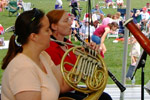
Bach Beethoven and Brunch Classical Music Series in Shadyside's Mellon Park presents free 90-minute classical music concerts. You can buy food on site, or pack your fanciest alfresco meal and take part in the best brunch competition. Courtesy CitiParks
10:30 a.m.
Begin your Sunday of cultural treats at the Bach, Beethoven and Brunch Classical Music Series in Shadyside’s Mellon Park.
Bring a picnic basket of goodies and a blanket and settle in for a 90-minute banquet of classical music. Food also is available for purchase.
But if you’re of a competitive nature, you may want to put some effort into your brunch menu. Each week, there’s a prize for the winner of the best brunch competition.
Presented by CitiParks, this popular event runs every Sunday through Aug. 15 and is free.
Upcoming performances include Pittsburgh Guitar Trio on Sunday and Allegheny Brass Band on July 25.
Details: 412-255-2391 or here
12:30 p.m.
It’s time to satisfy your appetite for visual art.
From Mellon Park head to the Oakland area.
Armed with your trusty Oakland edition of “Pittsburgh Art in Public Places,” begin your walking tour at the memorial fountain designed by Saint-Gaudens near the entrance to Carnegie Library of Pittsburgh.
The walking tour covers a lot of ground, taking you past 26 outdoor sculptures, monuments and statues at sites on the Carnegie Mellon University campus, in Schenley Park, outside of Soldiers and Sailors Memorial Hall and Museum and around Schenley Plaza and the Cathedral of Learning.
The complete walk takes between 75 minutes and two hours, longer if you take rest stops or hydration breaks.
2:30 p.m.
End your tour with a rest stop in Schenley Plaza. Take a spin on the carousel. Refuel with something snacky from one of the food kiosks. Possibilities include bagels and pastries at the Bagel Factory, sushi and bubble-tea drinks from Asia Tea House, gyros and salads from Opa Gyros and pizza rolls, pretzels and vegetarian options from Milky Way.
There’s an abundance of benches or cafe-style tables and chairs throughout the park. If you’re looking for shade, head to the big tent at one end of the park.
Some of you may be willing to call it a successful day out right here.
If you’ve not yet had your fill of art, continue on.
3:30 p.m.
Now, it’s time to explore the North Shore.
Firmly grasping your map of Walking Tour 2: North Shore from “Pittsburgh Art in Public Places: Downtown Walking Tour” begin at the Alcoa Building that faces the water between Sandusky and Anderson streets.
This second tour covers 22 sculptures, architectural wonders and statues that range from the traditional — bronze statues of Art Rooney Sr. and Honus Wagner to George Sugarman’s colorful aluminum abstract sculpture. Along the way you’ll pass long-standing landmarks, such as the former Buhl Planetarium and post office buildings, now re-purposed as the Pittsburgh Children’s Museum in Allegheny Center, and get close-up views of Pittsburgh’s two humongous sports stadiums.
This tour should take between 75 minutes and two hours, depending on how fast you walk and how often you linger.
5:30 p.m.
Dine alfresco at one of the many restaurants along North Shore Drive that offers outdoor dining.
Two possibilities:
• Jerome Bettis’ Grille 36 (412-224-6287 or here) offers a view of the river from beneath the black-and-gold umbrellas in its outdoor dining area. A full menu ranges from bar food and sandwiches to a 36-ounce strip steak served with mushrooms, onions, mashed potatoes and broccoli for $44.95.
• Calico Jack’s Cantina (412-322-7380 or here) also offers a view of the water from its outdoor tables along the restaurant’s northern side. It features a casual menu of Mexican and Cajun bayou dishes.
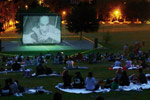
Cinema in the Park, presented on Schenley Park's Flagstaff Hill, offers free showings of recent movies. Courtesy CitiParks
8 p.m.
Finish your day with a movie or a play under the stars.
Each Sunday and Wednesday through Aug. 29, CitiParks’ Dollar Bank Cinema in the Park offers a screening of a recent film at Flagstaff Hill in Schenley Park. Upcoming Sunday films include “Imagine That” (this Sunday), “Astro Boy” (July 25) and “Bandslam” (Aug. 1). It’s part of a larger program that offers outdoor screenings in city parks throughout Pittsburgh.
Admission is free. Screenings begin at dusk.
Details: 412-422-6426 or here.
If you prefer live entertainment and can wait a few weeks, Quantum Theatre will be performing “The Howling Miller” (July 29 to Aug. 22) outdoors in a production that utilizes the burned-out Frick Environmental Center in Squirrel Hill as a background. Set in Lapland in the post-war years, the play revolves around a troubled stranger who is a man, a myth and a stranger who is part hero, part howler.
You’ll need to adjust your dinner plans slightly as Sunday performances begin at 7 p.m., but it’s at 8 p.m. Wednesdays through Saturdays. Admission is $30-$45; $16 for students.
Details: 412-697-2929 or here.
-
Historic Old Stone Tavern in Pittsburgh’s West End Awaits New Life
By Tony LaRussa
PITTSBURGH TRIBUNE-REVIEW
Monday, July 12, 2010
The Old Stone Tavern is believed to have served as a tollhouse and frontier trading post. It likely played a role in the Whiskey Rebellion, the late 18th-century uprising against a federal excise tax on liquor. Joe Appel | Pittsburgh Tribune-Review
It’s hard to see the building at the crossroads of Greentree Road and Woodville Avenue in the West End as anything but just another of the city’s many aged, vacant properties waiting for its date with a wrecking ball.
But some people are looking beyond the broken windows, peeling siding and thick ivy snaking up the sides. They see a gem.
Late last year, city officials ensured that whatever the future holds for the centuries-old building known as the Old Stone Tavern, its designation as a historic structure will prevent it from being torn down. The Historic Review Commission must give permission before an owner can alter its exterior.
Research done during the historic designation nominating process points to the likelihood that the tavern is the region’s second-oldest building, behind the Fort Pitt Blockhouse built in 1764 in what is now Point State Park.

This is the bar area of the Old Stone Tavern in the West End, which was designated a historic structure last year, protecting it from destruction. Joe Appel | Pittsburgh Tribune-Review
“It’s almost certainly the oldest commercial structure in the region,” said Michael Shealey, an architect who conducted much of the research.
The Old Stone Tavern is located at a bend in what was the historic Washington and Pittsburgh Turnpike, a toll road connecting Pittsburgh to Washington County and National Road. It is believed to have served as a tollhouse and frontier trading post and likely played a role in the Whiskey Rebellion, the late 18th-century uprising against a federal excise tax on liquor.
Despite the 1752 date chiseled into a cornerstone, evidence points to the structure’s construction in the early 1780s, Shealey said.
“We always knew it was very old, but never imagined it dated back as far as it apparently does,” said Norene Beatty, who testified at a public hearing in support of the historic designation. “Wouldn’t it be wonderful to see it restored and used as a rustic tavern like you would find in Colonial Williamsburg?”

An apparently original fireplace has been uncovered at the Old Stone Tavern at the crossroads of Greentree Road and Woodville Avenue in the West End. The structure is believed to be the second oldest in the City of Pittsburgh. Joe Appel | Pittsburgh Tribune-Review
Yet even though historic designation protects the building, it does not require someone to restore it.
Historic buildings can qualify for state and federal grants and tax credits, but the best hope for restoration lies in identifying a commercial use for the property, said Arthur Ziegler, president of the Pittsburgh History & Landmarks Foundation, which supported the nomination.
“Protecting the building was an important first step,” said Ziegler.
Diana Poliziani of Crafton Heights, whose family has owned businesses in the West End for 50 years, hopes the building is “put to good use.”
“I think the business district is going to explode in the next couple of years, and a historic building like that should be part of what happens,” she said.
John DiSantis, a former Historic Review Commission member who nominated the building for historic designation, said its preservation is important to the fabric of the community.
“When you’re talking about something this old, it really doesn’t matter how long it takes before something is done with it,” he said. “The key to me is that what exists now has been preserved.”
Lee Harris bought the old tavern last year, intending to tear it down to expand the adjacent masonry business started by his father.
“I knew it was one of the oldest buildings in the neighborhood, but I didn’t really know it had such historic significance,” he said.
Harris said that although people who pushed for the historic designation “were well-meaning,” it made doing business during a sour economy that much more difficult.
“I bought the place because I needed more space,” he said. “Now that I can’t tear it down, it’s really not much use to me.”
Harris didn’t fight the historic designation, took steps to keep the building from deteriorating further, and provided access to those interested in studying the structure. He estimates it would cost $250,000 to $500,000 to restore the tavern’s exterior and refurbish its interior, depending on the scope of the work.
He said he would consider selling the tavern and surrounding property, including the buildings he uses for his business, for a fair price and the cost of relocating if someone presented a development proposal.
Coming up with possible uses for the Old Stone Tavern is part of a master plan being developed with a $150,000 state grant extended to the nonprofit West End Partnership for Development.
“We’d love to see that area developed, so we can tie both sides of the West End together,” said Lou Bucci, the organization’s chairman. “Unfortunately, our organization doesn’t have the kind of money needed to take on a project like that. We’re hoping that as things improve economically, one of the foundations or a private developer will show some interest. We’d certainly do what we can to support them.”
-
Children’s Museum Has Plans to Beautify Unsightly Underpasses
By Bill Zlatos
PITTSBURGH TRIBUNE-REVIEW
Monday, July 12, 2010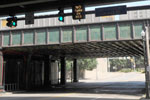
Underpass Artwork: The Norfolk & Southern Railroad underpass at Federal Street on the North Side has been proposed to be a public space gallery featuring murals and other artwork. Philip G. Pavely | Tribune-Review
Visitors from Downtown to the North Side must now pass through a dark maze of cold, concrete underpasses. But the Children’s Museum of Pittsburgh will soon inject it with a bit of brightness.
The museum is working with Norfolk & Southern Railroad and other groups to convert the railroad’s underpass on Federal Street near the post office into an outdoor art gallery. Work will start this fall and be finished in about a year.
“The underpasses have long been a blighted barrier between the neighborhoods of the North Side and the amenities of the North Shore,” said Mark Fatla, executive director of the Northside Leadership Conference.
The conference is working with the Urban Redevelopment Authority on another project to improve underpasses on Anderson and Sandusky streets. That involves new sidewalks, curbs and crosswalks.
The gallery project involves cleaning and painting the Federal Street underpass, and installing lights and a metal mesh where works of art can be hung. The new color of the bridge and its columns has not been determined.
“These railroad bridges and underpasses kind of contribute to that sense of inaccessibility and remoteness,” said Christopher Seifert, deputy director of the Children’s Museum. “The idea is to celebrate that entry, celebrate the bridges. We’ll use art to enhance the neighborhood spirit.”
The underpass gallery is part of the Charm Bracelet Project, which has encouraged two dozen North Side groups to work together. Among the Charm’s activities is free kayaking lessons on Lake Elizabeth with Venture Outdoors.
The cost of the gallery is estimated at $300,000. The main contributors are The Heinz Endowments, NRG Energy Co., the Grable Foundation and the National Endowment for the Arts.
“We imagine an individual artist with a regional or national reputation could do a one-person show,” Seifert said. “We could have a curated show from a half dozen artists or art from kids.”
Representatives from North Side groups will curate and coordinate the gallery project.
Fatla said some North Side residents hope that the underpass projects will draw visitors to their neighborhoods.
“I don’t think it will bring tons of customers to the near-North Shore neighborhoods,” he said. Rather, he continued, “If you buy a house here, you have a lovely pleasant walk to the ballpark, the riverfront trail or Downtown. It improves the value of living here.”
-
Carnegie Catholic Church May Get $7.1M Renewal
By Jeffrey Widmer
TRIBUNE-REVIEW NEWS SERVICE
Thursday, July 8, 2010The old St. Luke’s Church in Carnegie might gain new life.
The Carnegie planning commission last month approved plans to renovate the red brick church at Third Street and Third Avenue. It closed after being ravaged by flooding caused by Hurricane Ivan in September 2004.
It would reopen as the official center of the St. Elizabeth Ann Seton parish, though council must approve the plans.
According to information provided by the Rev. David Poecking in St. Luke’s June 13 bulletin, the parish hopes to have a final draft before the end of July.
The church estimates that the project will cost about $7.1 million; about $500,000 of that has been paid for, according to Poecking.
The parish has $3.4 million more for the project, leaving $3.2 million to be covered through a combination of further insurance payouts from the 2004 flood, the sale of Seton Hall in Carnegie and St. Ignatius in Scott, and a fund-raising campaign, Poecking said.

